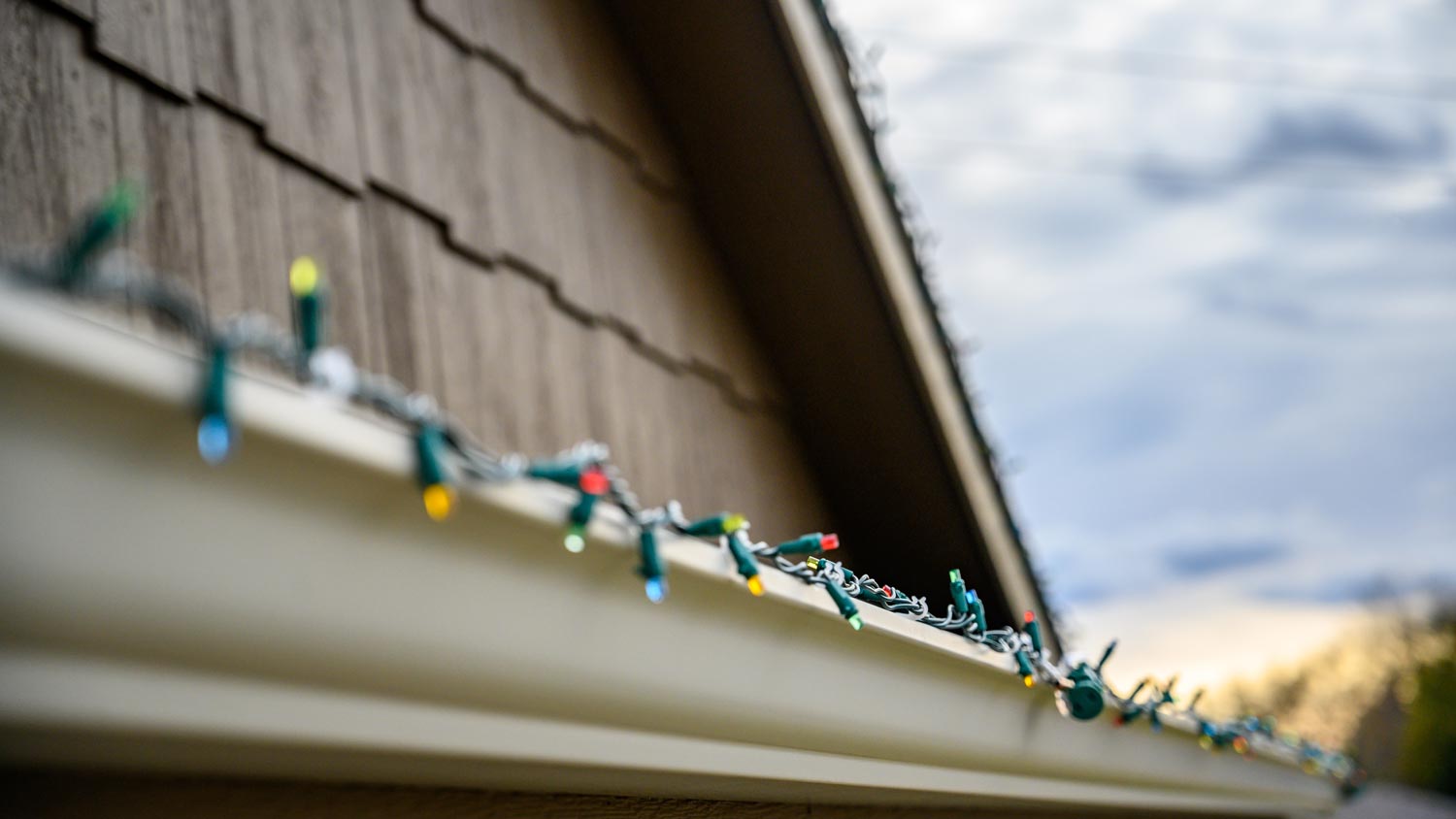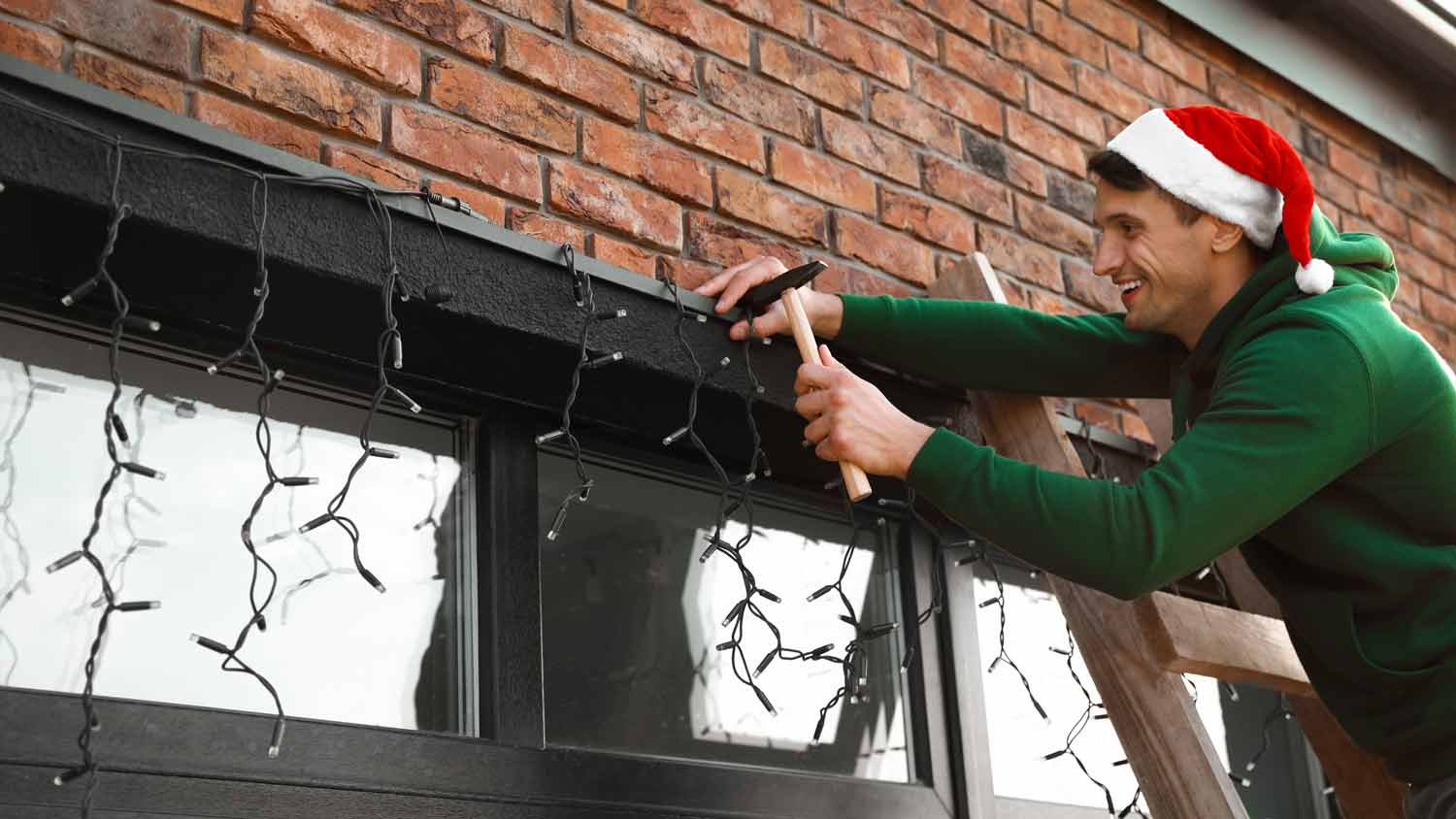How Many Feet of Christmas Lights Do You Need For Your House?
Deck the halls and count the bulbs


Need to calculate how many feet of Christmas light you need for your house? Whether you want to be the brightest house on the block or simply need a strand or two to get in the holiday spirit, careful measurements go a long way. Follow our guidelines to learn how to calculate the amount of Christmas lights you need this season.
How to Calculate How Many Christmas Lights You Need
When preparing to decorate your home’s exterior with Christmas lights, start with a minimum of 60 feet of string lights. Then, you should purchase 10 to 12 feet for every awning. For an exact calculation, measure your eaves and awnings to determine the length of lights needed. Let’s take a look at the best methods of determining your Christmas light order.
Measure Your House and Roof
You’ll need to measure your home, and decide which places you’d like to string lights, such as trees. When measuring hard-to-reach spots, remember to follow ladder safety guidelines.
Measure the length of the front of your home using a laser tool or tape measure.
Measure the length of the siding if you plan to string lights there.
If you have a patio or backyard that you want to decorate, measure those areas.
Measure any deck railings you wish to illuminate. If you want to wrap the lights rather than use clips, you’ll need an extra foot of length.
If you want to light a triangular-shaped roof, measure 26-and-a-half feet for each peak, based on a house that’s 25 feet long per side.
Add two feet to all the strand light measurements.
Add the totals together to get the length needed for your home.
Add Number of Lights Needed for Exterior Fixtures

Instead of measuring every tree and bush in your yard, use these standard measurements to find your total Christmas light needs for exterior features.
Trees: Purchase a 32-foot strand for every 1½ feet of the tree’s height, or approximately 500 to 600 lights for an eight-foot tree.
Bushes and hedges: Use one or two 4-foot-by-6-foot light nets per bush or hedge.
Windows and doors: Buy a 16-foot strand per single-width window or single door.
Window boxes: Use a 14-foot strand of 50 lights per window box.
Columns or Pillars: Purchase one 32-foot strand of 100 lights per seven vertical feet of column.
Deck Railings: Measure the length of your railing to figure out how many feet of Christmas lights you’ll need. If you plan to wrap the lights, add an extra foot to your measurement to make sure the whole deck is covered in lights.
Measure Your Christmas Tree
The general rule of thumb is that you’ll need 100 to 200 lights for every vertical foot of tree, depending on desired brightness levels.
Now that you’ve selected the perfect Christmas tree, it’s time to decorate. Measure the height of your tree.
For a standard-level brightness, multiply your tree’s height by 100.
For high-powered brightness, multiply your tree’s height by 200.
| Tree Height | Number of Strands | Strands for Brighter Tree |
|---|---|---|
| 4 feet | 4 strands or 400 lights | 5 strands or 500 lights |
| 5 feet | 5 strands or 500 lights | 6 strands or 600 lights |
| 6 feet | 6 strands or 600 lights | 7 strands or 700 lights |
| 7 feet | 7 strands or 700 lights | 8 strands or 800 lights |
| 8 feet | 8 strands or 800 lights | 9 strands or 900 lights |
Number of Lights for Most Houses
| Type of Object | Average Number of Lights | Additional Lighting Option |
|---|---|---|
| Exterior house eaves | 60 feet of string or icicle lights | 10 to 12 feet per additional awning |
| Front of average-size house | 200 mini lights | 100 C9 lights |
| Entire small-size house | 400 mini lights | 175 C9 lights |
| Two sides of average-size house | 500 mini lights | 250 C9 lights |
Classic Christmas lights never go out of style, which is why displaying mini or C9 bulbs on the eaves’ fascia can be a simple, yet stylish way to light your home. If your home is average or smaller in size—around 1,000 to 2,000 square feet—plan to use the below number of lights on the exterior of your house. Consult a local holiday decorator if you need professional help with your Christmas light installation.
Front of House
If you’re only decorating the front of your home or garage, you can use two strands of 32-foot mini lights on an average or small-sized house. That’s 200 lights total, but you’ll need to double the number of strands if you prefer to use the larger C9 lights in 16-foot lengths. In this instance, you’d use four strands of C9 lights for a total of 100 lights. Since C9 bulbs are so much brighter than the mini lights, you’ll typically use less strands than the mini lights, even though they come with fewer bulbs per strand.
Front and Sides
To adorn an average-sized house with two sides, you’ll need a total of 500 lights—four strands of 32-foot mini lights and two strands of 14-foot mini lights. If you use C9 bulbs, use 10 16-foot-long strands. Smaller houses, on the other hand, will need a total of 400 lights—four strands of 32-foot mini lights to be exact. If you opt for C9 bulbs, you’ll need 7 16-foot-long strands.
How to Identify the Types of Christmas Lights

Before you get out your calculator, it’s important to determine which style of Christmas lights you want to hang and where you want to hang them. The type of Christmas light you choose will change the number of lights per strand as well as the effect of the lighting. For example, do you want double the number of miniature lights, or would you prefer fewer lights, but bigger bulbs? Below, we break down the strand length and number of lights per strand for different types of bulbs. Keep in mind that these are standard-sized lights, but strands may come in several different lengths and bulb densities.
| Type of Bulb | Strand Length | Number of Lights Per Strand |
|---|---|---|
| M5 or Mini Lights | 14 feet | 50 lights |
| M5 or Mini Lights | 32 feet | 100 lights |
| Mini Icicle Lights | 26 feet | 300 lights |
| Large C9 | 16 feet | 25 lights |
| Medium C7 | 24 feet | 25 lights |
| Small C6 | 18 feet | 50 lights |
| Net Lights | 4-foot-by-6-foot or 2-foot-by-8-foot | 150 lights |
Tips for Hanging Christmas Lights

Now that you know how many Christmas lights you need, it’s time to do the fun part—hang them up! Here are some tips to make sure the process goes off without a hitch.
Test your lights: Make sure all the strands are in working condition before you climb the ladder and hang them on your home. Troubleshoot any issues by following this guide to fixing Christmas lights.
Check your power sources: Make sure you have outlets available for the lights and have plenty of extension cords.
Use light clips: Clips made for hanging lights are easy to use and won’t damage your home. Make sure the clips are appropriate for the weight of your lights.
Time your lights: Adding a timer with a light sensor will ensure your lights turn off during the day and light back up when dusk hits.
Attempting tasks that require ladders in snowy conditions poses a significant safety risk due to slippery surfaces and reduced visibility. It's safer and wiser to hire a snow removal professional who is equipped to handle these challeneges safely and effectively.
DIY vs. Hiring a Pro

Are these calculations making your head spin? Don’t fret—a local Christmas light installer can hang Christmas lights on your home for $218 to $649 on average. A professional will save you time and reduce the risk of any accidents, in case you’re not used to working on a ladder.
That said, if you feel comfortable with similar house projects and have the right tools (a ladder, clips for hanging, laser measure, and so on), it might be worth it to save the money for an extra Christmas gift or two.
Frequently Asked Questions
There’s no fixed answer to this question, as it depends on the size of your home and the number of lights you want to hang. On average, people spend one to four hours hanging Christmas lights. You should also consider hiring a holiday decorating service to get the job done quickly and efficiently.
Projection spotlights offer an alternative (or addition) to Christmas lights. You simply plug in the projection and aim it at the side of your house or garage and watch the lightshow happen.
Incandescent lights are glass bulbs with metallic filaments inside, while LEDs feature “light emitting diodes” that illuminate when they come in contact with an electrical current. You can buy either for your Christmas lights, but note that LED lights are more energy-efficient and have a longer lifespan.





- Types of Christmas Lights for Every Holiday Need, Explained
- How to Put Lights on a Christmas Tree Like a Pro
- How to Save Time and Money on Christmas Lights
- Choosing the Best Christmas Lights to Illuminate Your Holidays
- How to Hang Christmas Lights on Your Roof: A Complete DIY Guide
- How to Hang Christmas Lights Yourself for a Shimmering Holiday Season
- Professional Christmas Light Installation Guide: Costs, Pros & Cons Explained
- How to Store Christmas Lights for Tangle-Free Decorating Next Year
- Can You Put Christmas Lights on the Ground? Here’s What to Do
- How To Hang Christmas Lights Inside for a Festive Look











